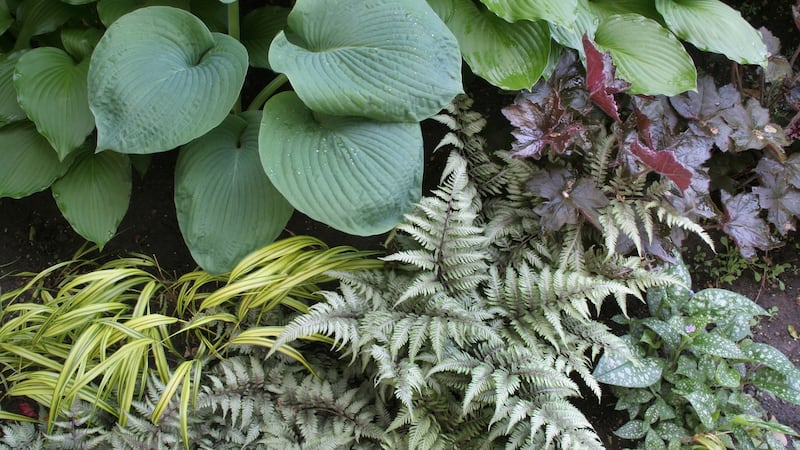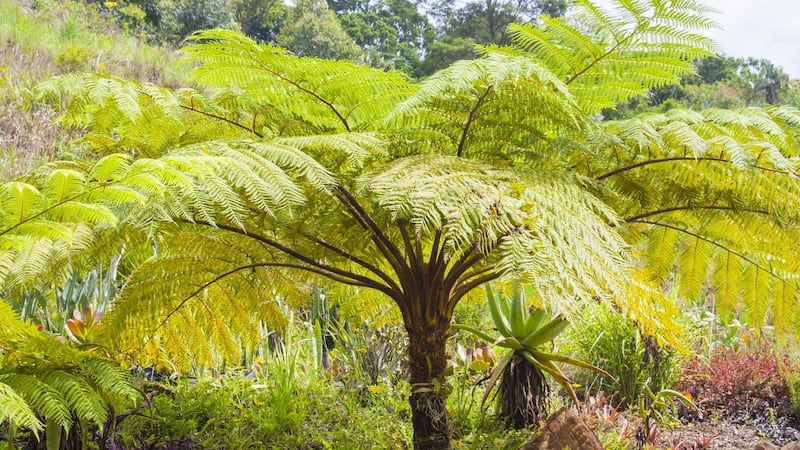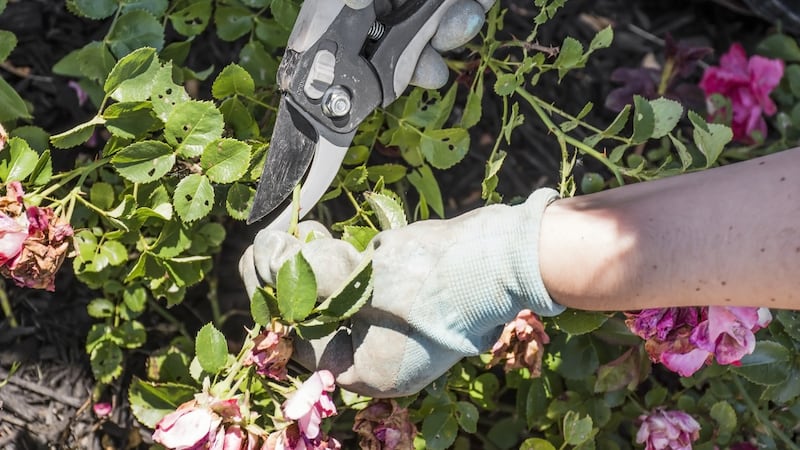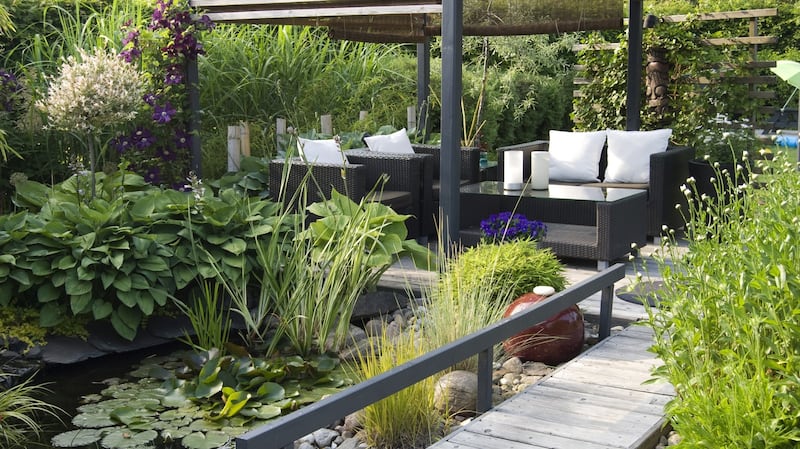Just like bees, we gardeners are drawn irresistibly to flowers, seduced by their beguiling colours and bewitching scents. It’s why garden centres make sure to stack their sales benches high with floral eye candy, knowing full well that we find it almost impossible to resist. It’s why every summer we stuff our pots, containers and window boxes full of pretty bedding plants, happily turning a blind eye to their shortcomings (their brief lifecycles, their need to be kept well-watered, fed and deadheaded), precisely because we prize their exotic butterfly-like beauty so very much.
By comparison, the power of foliage plants to transform a ho-humish sort of a garden into something special is a quality we often only slowly come to appreciate over the course of a lifetime’s gardening. Blinded by our love affair with flowers, we struggle to see what’s right under our noses, which is that foliage is the magic fairy dust that creates the sense of lushness, leafy seclusion and serenity found in almost every great garden.
By their nature, many of the very best foliage plants are trees or shrubs. Great garden-worthy examples include the deciduous, slow-growing Japanese maples (varieties of Acer palmatum, Acer japonicum and Acer shirasawanum such as the compact Acer “Chiyo Hime”, A “Katsura”, A “Green Cascade”, A “Bloodgood” and A “Aureum”) which are famed for their graceful growth habit and elegantly dissected leaves; different species of bamboos; box (buxus); Australian tree ferns (Dicksonia); the deciduous stag’s horn sumach (Rhus typhina) whose architectural pinnate leaves turn to glorious fiery shades in autumn; and the exotic looking, rice-paper plant (Tetrapanax papyrifer “Rex”) with its giant, deeply lobed leaves. In colder parts of the country the latter needs protection from harsh winter temperatures, as do many other exotic-looking fellow members of the aralia family including the lovely Taiwanese schefflera (Schefflera taiwaniana), species of Pseudopanax, the dramatically giant-leaved Fatsia polycarpa and the better known Fatsia japonica. Examples of more compact foliage plants that will add a lush green leafiness to the garden include many kinds of ferns, hostas and ornamental grasses.

Silver and grey
Other foliage plants have leaves in elegant shades of silver and grey. Examples include different species of eucalyptus; the weeping pear (Pyrus salicifolia “Pendula”); shrubby species such as the sun-loving wormwoods, Artemisia ludoviciana, Artemisia absinthium and Artemisia “Silver Queen”; drought-tolerant senecio (Brachyglottis); the evergreen but frost-hardy kerosene bush (Ozothamnus rosmarinifolius); the elegant Marrubium libantoticum, architectural Astelia ‘Silver Spear’; different species of lavender (Lavandula); teucrium and the shade-loving painted lady fern (Athyrium niponicum var. pictum). The latter example aside, most silver-grey foliage plants look right at home in a sunny gravel or Mediterranean-style garden (many originate in hot, arid regions of the world) and associate particularly well with plants with flowers in shades of blue, purple and pink.
Other well-known foliage plants have leaves in buttery shades of lime-green, yellow and gold, while some also give a wonderful flush of autumn colour. Tree and shrubby examples (along with the aforementioned Acer “Aureum”) include the sun-loving, fast-growing, false acacia tree, Robinia pseudoacacia “Frisia”; the deciduous, pollution-tolerant honey locust tree (Gleditisa triacanthos “Sunburst”), the golden-leaved, deciduous conifer Metasequoia “Goldrush”; golden ninebark (Physocarpus “Dart’s Gold”), golden elder (Sambucus “Aurea”), and the golden-leaved smoke bush (Cotinus coggygria “Golden Spirit”). More compact golden-leaved perennial species suitable for smaller spaces include shade-tolerant grasses such as Hakonechloa macra “All Gold” and Hakonechloa macra “Aureola”; the hardy, slug-resistant Hosta “Sum and Substance” whose giant, pleated leaves are a charming shade of lime green/yellow, shade-loving Brunnera”‘Green Gold”, and herbs such as golden marjoram and the variegated culinary sage, Salvia “Icterina”.

Golden foliage plants are excellent for lighting up any corner of the garden in dappled shade (many also do best when grown away from direct sunlight which can scorch their soft leaves) and associate particularly well with blue, white and orange-flowering plants. But be careful not to overdo them (too many in a garden can give a bilious effect) and make sure to add plenty of lush, green-leaved species to the mix.
Bronze and burgundy
Plants with red, purple, bronze, near-black and burgundy-coloured foliage (or a variegated mixture of some of these) are also popular with many gardeners. But again a gentle note of warning, which is that a lot depends on the intensity of leaf colour, the architectural quality of their leaves and their position in the garden. Unless carefully situated, species with dark shades of foliage can often create a jarring effect, or what many garden designers refer to as a visual black hole in the planting. A classic example is the large, fast-growing tree known as the purple Norway maple (Acer “Crimson King”), a deciduous species with distinctive dark wine/purple-coloured foliage that some gardeners (myself included) think is hideous but many others love.
Other foliage plants with leaves in these rich tones that are popular with gardeners (or perhaps I should say popular with some gardeners) include the black-leaved plum (Prunus cerasifera “Nigra”), a hardy, deciduous, small spring-flowering tree; many varieties of Japanese maple including Acer palmatum “Dissectum Atropurpureum”, the aforementioned Acer “Bloodgood”, Acer “Shaina” and Acer “Twombly’s Red Sentinel” (these I love); various species of the shrubby berberis genus; purple-leaved hazel (Corylus maxima “Purpurea”), smoke bush (Cotinus “Royal Purple”), black-leaved elder (Sambucus “Eva” , Sambucus “Black Lace” and Sambucus “Black Tower”); black ninebark (Physocarpus opulifolius “Diabolo”); the tender succulent shrub known as Aeonium “General Zwartkopf”; Phormium “Back in Black” and the tender Ethiopian banana (Muse ensete rubra) whose glossy burgundy-bronze leaves are a wonderfully dramatic addition to any exotic/ tropical-style summer garden. But whichever you plump for, restraint is of the essence when it comes to using these moody tones; too many in a garden will inevitably create an effect that’s gloomy verging on funereal.

Last but not least, there’s a little bit of housekeeping to bear in mind when it comes to tending these colourful foliage plants, which is that they occasionally produce branches with plain green leaves, a process known as reversion. When/if this happens, just prune these out with a sharp secateurs. Sometimes the opposite happens, and the parent plant produces a branch with leaves that are distinctly and excitingly different from the rest in terms of their colour, shape and/or growth habit. A naturally-occurring, spontaneous/chance but stable mutation, this is known in horticulture as a sport. Many outstanding new garden varieties have arisen in this way, spotted by eagle-eyed gardeners, plant breeders and nursery owners who then propagate them as brand new garden-worthy varieties. So do make sure to keep your eyes peeled . . .
This Week in the Garden
Deadhead faded roses by nipping out the individual dead flowers just below where the base of each flower joins the stem. When all of the flowers clustered together on a stem have finished, then use a sharp secateurs to cut back the stem to just above the first outward facing leaf with five leaflets.
Keep on top of weeds by nipping young growth in the bud. A good garden hoe is the ideal tool for the job. Just make sure to use it on a bright, dry day so that any freshly hoed weed seedlings will quickly wither rather than re-rooting. Freshly hoed/pulled weeds can be safely added to your compost heap as long as they haven’t yet set seed. Otherwise it’s best to bag them unless you’re confident that your compost heap is hot enough to kill any seeds.

Dates For Your Diary
Tomorrow, Sunday July 4th, (10am-4pm), Fruitlawn Garden, Abbeyleix, County Laois, Open Day with rare plants for sale and refreshments, see arthurshackleton.com; Sunday July 11th (9am-5pm), Airfield Estate, Dundrum, Dublin 14, sees the welcome return of the Rare & Special Plant Fair 2021 with over 40 specialist plant nurseries and suppliers selling a wide range of plants and garden supplies. Admission is €6 per person, see airfield.ie for details.











